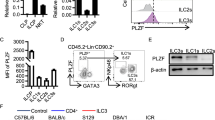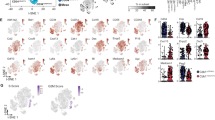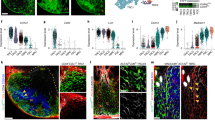Abstract
Fetal lymphoid tissue inducer (LTi) cells are required for lymph node and Peyer's patch (PP) organogenesis, but where these specialized group 3 innate lymphoid cells (ILC3s) develop remains unclear. Here, we identify extrahepatic arginase-1+ Id2+ fetal ILC precursors that express a transitional developmental phenotype (ftILCPs) and differentiate into ILC1s, ILC2s and ILC3s in vitro. These cells populate the intestine by embryonic day (E) 13.5 and, before PP organogenesis (E14.5–15), are broadly dispersed in the proximal gut, correlating with regions where PPs first develop. At E16.5, after PP development begins, ftILCPs accumulate at PP anlagen in a lymphotoxin-α–dependent manner. Thus, ftILCPs reside in the intestine during PP development, where they aggregate at PP anlagen after stromal cell activation and become a localized source of ILC populations.
This is a preview of subscription content, access via your institution
Access options
Subscribe to this journal
Receive 12 print issues and online access
$209.00 per year
only $17.42 per issue
Buy this article
- Purchase on Springer Link
- Instant access to full article PDF
Prices may be subject to local taxes which are calculated during checkout






Similar content being viewed by others
References
Eberl, G. et al. An essential function for the nuclear receptor RORγt in the generation of fetal lymphoid tissue inducer cells. Nat. Immunol. 5, 64–73 (2004).
Yoshida, H. et al. IL-7 receptor α+ CD3– cells in the embryonic intestine induces the organizing center of Peyer's patches. Int. Immunol. 11, 643–655 (1999).
De Togni, P. et al. Abnormal development of peripheral lymphoid organs in mice deficient in lymphotoxin. Science 264, 703–707 (1994).
Fütterer, A., Mink, K., Luz, A., Kosco-Vilbois, M.H. & Pfeffer, K. The lymphotoxin β receptor controls organogenesis and affinity maturation in peripheral lymphoid tissues. Immunity 9, 59–70 (1998).
Honda, K. et al. Molecular basis for hematopoietic/mesenchymal interaction during initiation of Peyer's patch organogenesis. J. Exp. Med. 193, 621–630 (2001).
Koni, P.A. et al. Distinct roles in lymphoid organogenesis for lymphotoxins α and β revealed in lymphotoxin β–deficient mice. Immunity 6, 491–500 (1997).
Okuda, M., Togawa, A., Wada, H. & Nishikawa, S. Distinct activities of stromal cells involved in the organogenesis of lymph nodes and Peyer's patches. J. Immunol. 179, 804–811 (2007).
Spits, H. & Cupedo, T. Innate lymphoid cells: emerging insights in development, lineage relationships, and function. Annu. Rev. Immunol. 30, 647–675 (2012).
Yokota, Y. et al. Development of peripheral lymphoid organs and natural killer cells depends on the helix-loop-helix inhibitor Id2. Nature 397, 702–706 (1999).
Moro, K. et al. Innate production of TH2 cytokines by adipose tissue-associated c-Kit+Sca-1+ lymphoid cells. Nature 463, 540–544 (2010).
Satoh-Takayama, N. et al. IL-7 and IL-15 independently program the differentiation of intestinal CD3-NKp46+ cell subsets from Id2-dependent precursors. J. Exp. Med. 207, 273–280 (2010).
Klose, C.S. et al. Differentiation of type 1 ILCs from a common progenitor to all helper-like innate lymphoid cell lineages. Cell 157, 340–356 (2014).
Constantinides, M.G., McDonald, B.D., Verhoef, P.A. & Bendelac, A. A committed precursor to innate lymphoid cells. Nature 508, 397–401 (2014).
Cherrier, M., Sawa, S. & Eberl, G. Notch, Id2, and RORγt sequentially orchestrate the fetal development of lymphoid tissue inducer cells. J. Exp. Med. 209, 729–740 (2012).
Sandler, N.G., Mentink-Kane, M.M., Cheever, A.W. & Wynn, T.A. Global gene expression profiles during acute pathogen-induced pulmonary inflammation reveal divergent roles for Th1 and Th2 responses in tissue repair. J. Immunol. 171, 3655–3667 (2003).
Herbert, D.R. et al. Alternative macrophage activation is essential for survival during schistosomiasis and downmodulates T helper 1 responses and immunopathology. Immunity 20, 623–635 (2004).
Hesse, M. et al. Differential regulation of nitric oxide synthase-2 and arginase-1 by type 1/type 2 cytokines in vivo: granulomatous pathology is shaped by the pattern of L-arginine metabolism. J. Immunol. 167, 6533–6544 (2001).
Munder, M., Eichmann, K. & Modolell, M. Alternative metabolic states in murine macrophages reflected by the nitric oxide synthase/arginase balance: competitive regulation by CD4+ T cells correlates with Th1/Th2 phenotype. J. Immunol. 160, 5347–5354 (1998).
Bando, J.K., Nussbaum, J.C., Liang, H.E. & Locksley, R.M. Type 2 innate lymphoid cells constitutively express arginase-I in the naive and inflamed lung. J. Leukoc. Biol. 94, 877–884 (2013).
Reese, T.A. et al. Chitin induces accumulation in tissue of innate immune cells associated with allergy. Nature 447, 92–96 (2007).
Kanamori, Y. et al. Identification of novel lymphoid tissues in murine intestinal mucosa where clusters of c-kit+ IL-7R+ Thy1+ lympho-hemopoietic progenitors develop. J. Exp. Med. 184, 1449–1459 (1996).
Eberl, G. & Littman, D.R. Thymic origin of intestinal αβ T cells revealed by fate mapping of RORγt+ cells. Science 305, 248–251 (2004).
Eberl, G. Inducible lymphoid tissues in the adult gut: recapitulation of a fetal developmental pathway? Nat. Rev. Immunol. 5, 413–420 (2005).
Adachi, S., Yoshida, H., Kataoka, H. & Nishikawa, S. Three distinctive steps in Peyer's patch formation of murine embryo. Int. Immunol. 9, 507–514 (1997).
Klose, C.S. et al. A T-bet gradient controls the fate and function of CCR6-RORγt+ innate lymphoid cells. Nature 494, 261–265 (2013).
Vonarbourg, C. et al. Regulated expression of nuclear receptor RORγt confers distinct functional fates to NK cell receptor-expressing RORγt+ innate lymphocytes. Immunity 33, 736–751 (2010).
El Kasmi, K.C. et al. Toll-like receptor-induced arginase 1 in macrophages thwarts effective immunity against intracellular pathogens. Nat. Immunol. 9, 1399–1406 (2008).
Yagi, R. et al. The transcription factor GATA3 is critical for the development of all IL-7Rα-expressing innate lymphoid cells. Immunity 40, 378–388 (2014).
van de Pavert, S.A. et al. Maternal retinoids control type 3 innate lymphoid cells and set the offspring immunity. Nature 508, 123–127 (2014).
de Boer, J. et al. Transgenic mice with hematopoietic and lymphoid specific expression of Cre. Eur. J. Immunol. 33, 314–325 (2003).
Luche, H., Weber, O., Nageswara Rao, T., Blum, C. & Fehling, H.J. Faithful activation of an extra-bright red fluorescent protein in “knock-in” Cre-reporter mice ideally suited for lineage tracing studies. Eur. J. Immunol. 37, 43–53 (2007).
Acknowledgements
The authors thank V. Nguyen (UCSF Flow Cytometry Core) and Z. Wang (Sabre Sorting Facility) for cell sorting, and D. Sheppard, D. Kioussis (MRC National Institute for Medical Research), D. Littman (New York University), E. Robey (University of California, Berkeley), H. Luche and H. Fehling (University Clinics Ulm, Germany) for providing mice for these studies. We also thank J. Cyster and L. Lanier for critical reading of the manuscript. Supported by the Howard Hughes Medical Institute (R.M.L.), National Institutes of Health (AI026918, AI030663 and AI119944 to R.M.L.), the Sandler Asthma Basic Research Center at UCSF (R.M.L.) and the UCSF Biomedical Sciences (BMS) Graduate Program (J.K.B.).
Author information
Authors and Affiliations
Contributions
J.K.B. and R.M.L. designed experiments and wrote the manuscript. J.K.B. conducted experiments and H.-E.L. provided reagents.
Corresponding author
Ethics declarations
Competing interests
The authors declare no competing financial interests.
Integrated supplementary information
Supplementary Figure 1 Characterization of Arg1-YFP+NK1.1+ cells.
(a) YFP expression in NK1.1+CD3- cells from the spleen and liver of Arg1YFP mice at different ages post-birth. (b) RORγ(t) protein expression in YFP+NK1.1+ cells sorted from spleens of 20-day-old Arg1YFP mice. The gray shaded area indicates CD4+ T cells. (c) YFP expression in NK1.1+ cells from Arg1YFPRag2−/− spleens of 20-day-old mice. (d) Eomesodermin expression in YFP+NK1.1+ cells sorted from spleens of 20-day-old Arg1YFP mice (solid line). The gray shaded area represents an isotype control and the dotted line represents sorted YFP−NK1.1+CD5− NK cells. (e) Expression of IL-7Rα, NKp46, and NKG2D in adult spleen and liver. Shaded areas indicate isotype controls. Data are representative of 2 independent experiments (a-e).
Supplementary Figure 2 Dissection strategy for determining YFP+ cell localization before PP development.
Division of the fetal small intestine into three regions of equal length for flow cytometry experiments in Fig. 3a.
Supplementary Figure 3 Arg1 is not required for PP development.
PP numbers per intestine (left) and follicles per PP (right) in VavcreArg1fl/fl mice and VavcreArg1fl/+ controls (n = 7 mice per group or n = 54-56 PP). P>0.05 (unpaired Student’s t-test). Data are pooled from two independent experiments.
Supplementary Figure 4 Specificity of RORγ(t) antibodies to RORγt in fetal Arg1+ ILCs.
Rorc(γt)GFP/+ or Rorc(γt)GFP/GFP (knockout) cells from E16.5 intestines were stained with RORγ(t) antibodies. Cells were pre-gated on CD45+CD11b−IL-7Rα+ cells, and then further gated on CD4+NK1.1− cells for LTis, ST2+NK1.1− cells for ILC2s, or CD4−NK1.1−ST2− cells to enrich for RNT− cells. Data are representative of two independent experiments.
Supplementary Figure 5 A subset of Arg1+RNT− cells expresses CD25.
(a) CD25 staining in Arg1YFP+RORγt(fm)−NK1.1− cells isolated from E15.5 fetal intestines. CD25 expressing RNT− cells are shown in the top left quadrant. (b) T-bet and RORγ(t) expression in Arg1YFP+RNT−CD25− (left quadrants) and Arg1YFP+RNT−CD25+ cells (right quadrants) isolated from E16.5 fetal intestines. (c) Histograms for T-bet and RORγ(t) expression in Arg1YFP+RNT−CD25− cells. Data are representative of two independent experiments.
Supplementary Figure 6 Transcription factor expression in GATA-3+ fetal liver ILC precursors.
Transcription factor staining in E14.5 Lin−IL-7Rα+α4β7+Flt3−CD25−ST2− fetal liver cells. Data are representative of three independent experiments.
Supplementary Figure 7 Functional assessment of ILCs derived from Arg1-YFP+RNT− cells.
(a) Cytokine expression by 3 h PMA-and Ionomycin-stimulated ILCs at day 10 of culture. (b) LTα1β2 expression by ILCs at day 10 of culture. Data are representative of two independent experiments (a-b).
Supplementary Figure 8 Variation between experiments pooled for Figure 5h.
Each pie represents an independent experiment in which 96 single Arg1YFP+RNT− cells were sorted and cultured for 6 days.
Supplementary Figure 9 Arg1+RNT− cells in adult intestinal tissue.
CD45+, lymphocyte-sized Arg1+ cells in adult lamina propria and Peyer’s patches include NK1.1−RORγt(fm)−KLRG1−CD25− cells. Data are representative of two independent experiments.
Supplementary information
Supplementary Text and Figures
Supplementary Figures 1–9 (PDF 1789 kb)
Rights and permissions
About this article
Cite this article
Bando, J., Liang, HE. & Locksley, R. Identification and distribution of developing innate lymphoid cells in the fetal mouse intestine. Nat Immunol 16, 153–160 (2015). https://doi.org/10.1038/ni.3057
Received:
Accepted:
Published:
Issue Date:
DOI: https://doi.org/10.1038/ni.3057
This article is cited by
-
Group 2 innate lymphoid cells and their surrounding environment
Inflammation and Regeneration (2023)
-
Proline fuels ILC3s to maintain gut health
Nature Metabolism (2023)
-
Proline uptake promotes activation of lymphoid tissue inducer cells to maintain gut homeostasis
Nature Metabolism (2023)
-
Evaluation of circulating innate lymphoid cells in the early pathogenesis of mouse colorectal carcinoma
Comparative Clinical Pathology (2023)
-
Control of lymphocyte functions by gut microbiota-derived short-chain fatty acids
Cellular & Molecular Immunology (2021)



